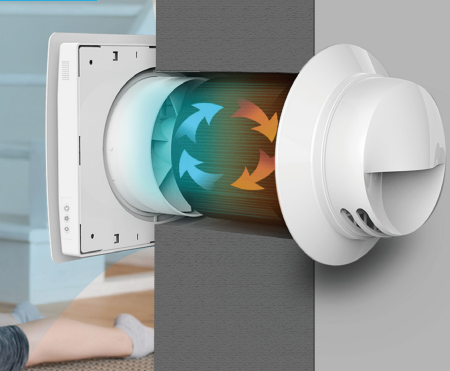7 Indicators You Could Benefit From HRV in Your Home
Wiki Article
How Heat Recovery Ventilation Improves Indoor Air Top Quality and Reduces Power Expenses
Heat Recovery Ventilation (HRV) systems play a crucial duty in enhancing indoor air top quality while all at once reducing power expenses. By successfully exchanging stagnant interior air with fresh exterior air, HRVs assist keep optimal moisture and lower pollutants. Furthermore, their capacity to recuperate warm from outgoing air decreases the strain on heating and cooling down systems. As energy prices continue to increase, comprehending the full capacity of HRV systems becomes significantly important for house owners and businesses alike.Comprehending Heat Recovery Ventilation Systems

Heat recovery ventilation (HRV) systems play a necessary duty in enhancing indoor air high quality, specifically in modern, energy-efficient buildings. These systems are made to transfer warm from the outbound stagnant air to the inbound fresh air, thereby minimizing energy loss while preserving suitable temperature level degrees indoors. HRVs consist of a warm exchanger, fans, and ductwork, facilitating the constant flow of air. By getting rid of interior pollutants and presenting fresh air, HRVs aid to balance moisture degrees, prevent mold development, and reduce allergens. The efficiency of HRV systems lies in their ability to recover up to 80% of the heat from the exhausted air, promoting energy conservation while ensuring a healthy interior setting. Their assimilation is crucial in accomplishing sustainable living methods.
The Significance of Indoor Air Quality
Indoor air quality (IAQ) is a critical element affecting the wellness and wellness of residents in any environment. Poor IAQ can bring about different health and wellness problems, consisting of breathing troubles, allergic reactions, and fatigue. Furthermore, it can intensify current conditions such as asthma. Elements adding to low IAQ include pollutants from indoor resources like cleaning up representatives, mold, and poor air flow. Subsequently, keeping good IAQ is crucial for advertising a risk-free and comfortable living or working space. Reliable methods to improve IAQ entail routine tracking of air quality, proper air flow systems, and reducing using dangerous substances indoors. By focusing on IAQ, people can ensure a healthier setting that fosters performance and overall top quality of life.Energy Effectiveness Benefits of HRV Systems
Many homeowners and structure managers are increasingly recognizing the energy effectiveness advantages of warm healing air flow (HRV) systems. By moving warm from worn down indoor air to incoming fresh air, HRV systems considerably decrease the energy needed for heating & cooling. This process minimizes reliance on traditional heating and cooling systems, resulting in lower energy expenses. Furthermore, HRVs assist preserve a balanced interior environment, preventing extreme heating or cooling down needs. The ability to recover as much as 90% of the warm from outward bound air likewise sustains sustainability initiatives by reducing total energy usage. HRV systems contribute not just to set you back savings yet likewise to a decreased carbon footprint, straightening with the growing focus on energy-efficient structure practices.Installment and Maintenance Considerations
The effective execution of heat healing air flow (HRV) systems requires cautious factor to consider of installation and maintenance variables to ensure peak efficiency. Proper positioning of the HRV device is vital, as it should be mounted in a location that takes full advantage of air flow while decreasing noise interruption. Additionally, ductwork must be suitably sized and insulated to avoid energy loss. Regular upkeep, including filter substitute and system cleansing, is important to secure ideal capability and find more info indoor air high quality. Proprietors should develop a normal maintenance routine to recognize and deal with possible concerns before they escalate. Partnership with knowledgeable specialists during both installment and upkeep phases can enhance the long life and performance of HRV systems, eventually leading to far better indoor settings and decreased power expenses.
Real-World Applications and Success Stories
Discovering real-world applications of warm recuperation ventilation (HRV) systems discloses their significant effect on indoor air top quality and energy effectiveness throughout different setups. In domestic structures, homeowners have reported improved air quality, leading to fewer allergic reactions and respiratory system issues. Schools applying HRV systems have kept in mind boosted trainee focus and reduced absence as a result of far better air flow. Industrial structures, such as workplaces and retail rooms, have actually experienced lower energy expenses and raised worker productivity. A corporate workplace in a pleasant environment accomplished a 30% reduction in energy costs after mounting an HRV system. These success stories demonstrate that HRV technology not just contributes to healthier settings yet likewise offers tangible economic benefits, making it a beneficial investment for various sectors.Frequently Asked Questions
Can HRV Systems Decrease Allergens in Indoor Air?
The efficiency of HRV systems in lowering interior irritants primarily rests on their ability to filter and exchange air. HRV Heat Recovery Ventilation. By continually changing stale air, these systems can significantly decrease allergen degrees throughout indoor settings
Exactly How Does Humidity Affect HRV System Efficiency?
Moisture significantly influences HRV system efficiency; high levels can result in condensation, reducing performance, while low humidity might enhance air exchange. Stabilizing humidity is important for ideal procedure and maintaining interior air high quality.Are HRV Systems Noisy Throughout Operation?
HRV systems can create differing noise levels during procedure, depending on their design and setup. Some systems operate quietly, while others may generate noticeable audio, particularly at greater air flow setups or when badly address kept.What Is the Average Life-span of an HRV System?

Can HRV Systems Be Made Use Of in All Environments?
HRV systems can be used in numerous climates, yet their efficiency might vary - HRV Heat Recovery Ventilation. In extreme temperature levels, modifications or supplementary systems may be essential to ensure ideal efficiency and convenience while maintaining indoor air high qualityReport this wiki page